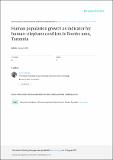| dc.contributor.author | Mmbaga, Naza | |
| dc.contributor.author | Munishi, Linus | |
| dc.contributor.author | Treydte, Anna | |
| dc.date.accessioned | 2019-05-21T10:11:57Z | |
| dc.date.available | 2019-05-21T10:11:57Z | |
| dc.date.issued | 2017-04-17 | |
| dc.identifier.issn | 2222-3045 | |
| dc.identifier.uri | https://doi.org/10.1126/science.1158900. | |
| dc.identifier.uri | http://dspace.nm-aist.ac.tz/handle/123456789/114 | |
| dc.description | Research Article published by Journal of Biodiversity and Environmental Sciences (JBES) Vol. 10, No. 4, 2017 | en_US |
| dc.description.abstract | Conservationists need detailed information on human population growth and distribution in areas adjacent to
protected areas. This information can help determine land use/land cover changes (LULCC), which affect the
quality and quantity of elephant habitat and, thus, elephant populations. We assessed the influence of human
population trends on demographic characteristics on the African elephant (Loxodonta Africana) population and
related conflicts with people in Rombo, Tanzania. Data on household surveys, focus group discussions, site
observations and human census records as well as reported human-elephant conflict (HEC) incidents were
included. A Digital Elevation Model in GIS was used to produce a map showing spatial distribution of human
population density along an altitudinal gradient in relation to LULCC and HEC status. We found that, over the
past 40 years, the human population in Rombo area has been growing fast, with an increment of 128% from 1967
to 2012. The population density was low in lower altitudes (<1230 masl), which were strongly used for seasonal
cropping and highly dominated by HEC (98%). Settlements expanded from 1987 to 2015 by 30%, particularly at
higher altitudes. Most respondents only attained primary education (72%) and strongly depended on agriculture
(99%) to sustain their livelihoods. We conclude that with the increasing human population and alteration of land
use need interventions to sustain elephant conservation and livelihood of the people. We recommend the
establishment of buffer zones for elephant conservation and tourism activities in the lowland areas. | en_US |
| dc.language.iso | en_US | en_US |
| dc.publisher | Journal of Biodiversity and Environmental Sciences (JBES) | en_US |
| dc.subject | Loxodonta africana | en_US |
| dc.subject | Land use land cover change | en_US |
| dc.subject | Altitudinal gradient | en_US |
| dc.title | Human population growth as indicator for human-elephant conflicts in Rombo area, Tanzania | en_US |
| dc.type | Article | en_US |

